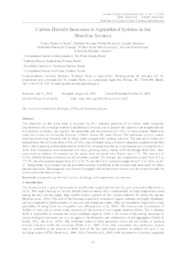Carbon dioxide emissions in agricultural systems in the Brazilian savanna.
Carbon dioxide emissions in agricultural systems in the Brazilian savanna.
Author(s): SOUZA, J. P. de; BORTOLON, E. S. O.; BORTOLON, L.; CAMARGO, F. P. de; CONCEIÇÃO, W. S. S.; LIMA, A. de O.; VEZZANI, F. M.
Summary: The objectives of this work were to evaluate the CO2 emission potential of an Oxisol under integrated crop-livestock and no-tillage systems in the Brasilian Savanna; and to analyze the impact of soil temperature and soil moisture as factors that regulate the seasonality and the emission of C-CO2 in these systems. Field-scale study was carried out at Fazenda Brejinho, in Pedro Afonso-TO, under Oxisol. The production systems studied were integrated crop-livestock and no-tillage under cropped with soybean and corn. The amount of carbon (C) released from the soil in the form of CO2 (C-CO2) was evaluated using cylindrical chambers installed in the field with a vial containing sodium hydroxide to collect CO2 released from the soil (soil emission) in an interval of 15 hours. Five evaluations were conducted over crops growing season, started in 01/26 through 06/16/2015. Data were tested to analysis of variance and the means were compared with Duncan test at 5%. The emission of C-CO2 differed between treatments in all evaluation periods. On average, the temperature ranged from 26.5 to 27.7 °C, the soil moisture ranged from 12.2 to 15.7% and the C-CO2 emission ranged from 87.4 to 119.9 mg m-2 h-1. Temperature, soil moisture and the production systems contributed to the emission and seasonality of carbon dioxide emissions. The integrated crop-livestock cropped with soybean/corn rotation was the system that had the lowest carbon dioxide emission.
Publication year: 2019
Types of publication: Journal article
Keywords: Carbono, Cerrado, Dióxido de Carbono, Plantio Direto, Temperatura do Solo
Observation
Some of Embrapa's publications are published as ePub files. To read them, use or download one of the following free software options to your computer or mobile device. Android: Google Play Books; IOS: iBooks; Windows and Linux: Calibre.
Access other publications
Access the Agricultural Research Database (BDPA) to consult Embrapa's full library collection and records.
Visit Embrapa Bookstore to purchase books and other publications sold by Embrapa.

